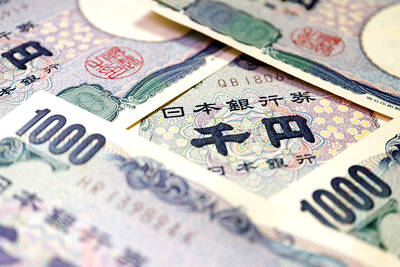The government’s business monitoring system edged up to flash “yellow-blue” last month, after flashing “blue” for 10 consecutive months, aided by better imports of machinery and electrical equipment, but the improvement might not last amid a stalling global economy, the National Development Council (NDC) said yesterday.
“The yellow-blue light was an indication that the economy is changing gears, but it is hard to say whether it would turn better or worse,” council research director Wu Ming-huei (吳明蕙) said at a press conference.
Wu cited as an example leading indicators, which resumed a mild downturn last month after holding steady one month earlier, suggesting continued economic weakness.
The total score for the council’s business indicators rose to 17 last month, just one point above the recessionary “blue” zone, the council’s report showed.
Imports of machineries and electrical equipment usually stem from export needs, and expectations of better orders and sales likely drove local companies to expand manufacturing capacity, Wu said.
Technology companies by and large gave a conservative guidance about their business outlook for the current quarter, but expect a concrete improvement in the second half of the year.
The council’s trend-adjusted leading indicators, which predict the economic scene one to six months ahead, dipped 0.25 percent to 97.72, as the semiconductor book-to-bill ratio and Taiwan Stock Exchange closing prices registered positive cyclical movements.
However, the indices on export orders, building permits and money supply declined, the report said.
In particular, the contraction in export orders widened to double-digit percentage points last month, indicating that actual shipments this month might deteriorate after the pace of decline eased one month earlier.
The coincident indicators, a mirror of current economic status, slid 0.05 percent to 98.26 last month, constrained by tepid exports, industrial production sales, and wholesale and retail business, the report said.
“Against this backdrop, consumers will hesitate to spend freely,” Wu said.
Separately, the consumer confidence index shed 0.55 points to 79.82 this month, dropping below the 80-point level for the first time since January 2014, a survey by National Central University showed yesterday.
All six sub-indices lost values as uneasy sentiment deepened, the survey indicated.
The reading on inflationary expectations reported the biggest fall of 1.55 points to 56.65, consistent with gradual hikes in international crude prices, while the gauge on employment fell 0.75 points and the measure on investment outlook shed 0.7 points, the survey showed.
People voiced less confidence about household income in the coming six months and turned slightly more conservative about durable goods consumption, it showed.

AI TALENT: No financial details were released about the deal, in which top Groq executives, including its CEO, would join Nvidia to help advance the technology Nvidia Corp has agreed to a licensing deal with artificial intelligence (AI) start-up Groq, furthering its investments in companies connected to the AI boom and gaining the right to add a new type of technology to its products. The world’s largest publicly traded company has paid for the right to use Groq’s technology and is to integrate its chip design into future products. Some of the start-up’s executives are leaving to join Nvidia to help with that effort, the companies said. Groq would continue as an independent company with a new chief executive, it said on Wednesday in a post on its Web

RESPONSE: The Japanese Ministry of Finance might have to intervene in the currency markets should the yen keep weakening toward the 160 level against the US dollar Japan’s chief currency official yesterday sent a warning on recent foreign exchange moves, after the yen weakened against the US dollar following Friday last week’s Bank of Japan (BOJ) decision. “We’re seeing one-directional, sudden moves especially after last week’s monetary policy meeting, so I’m deeply concerned,” Japanese Vice Finance Minister for International Affairs Atsushi Mimura told reporters. “We’d like to take appropriate responses against excessive moves.” The central bank on Friday raised its benchmark interest rate to the highest in 30 years, but Bank of Japan Governor Kazuo Ueda chose to keep his options open rather than bolster the yen,

Even as the US is embarked on a bitter rivalry with China over the deployment of artificial intelligence (AI), Chinese technology is quietly making inroads into the US market. Despite considerable geopolitical tensions, Chinese open-source AI models are winning over a growing number of programmers and companies in the US. These are different from the closed generative AI models that have become household names — ChatGPT-maker OpenAI or Google’s Gemini — whose inner workings are fiercely protected. In contrast, “open” models offered by many Chinese rivals, from Alibaba (阿里巴巴) to DeepSeek (深度求索), allow programmers to customize parts of the software to suit their

GROWING OWINGS: While Luxembourg and China swapped the top three spots, the US continued to be the largest exposure for Taiwan for the 41st consecutive quarter The US remained the largest debtor nation to Taiwan’s banking sector for the 41st consecutive quarter at the end of September, after local banks’ exposure to the US market rose more than 2 percent from three months earlier, the central bank said. Exposure to the US increased to US$198.896 billion, up US$4.026 billion, or 2.07 percent, from US$194.87 billion in the previous quarter, data released by the central bank showed on Friday. Of the increase, about US$1.4 billion came from banks’ investments in securitized products and interbank loans in the US, while another US$2.6 billion stemmed from trust assets, including mutual funds,